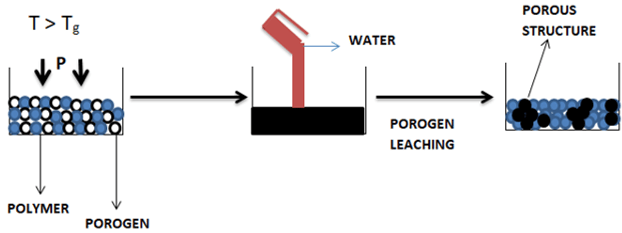This set of Tissue Engineering Multiple Choice Questions & Answers (MCQs) focuses on “Fabrication Methods of Biomaterials”.
1. Which of the following is not a conventional method of fabrication of biomaterials?
a) Solvent-casting
b) Particulate-leaching
c) Gas-foaming
d) Electrospinning
View Answer
Explanation: Solvent-casting, Particulate-leaching, and gas-foaming are conventional fabrication methods of biomaterials. Electrospinning is an advanced fabrication method.
2. Which of the following is not an advanced method of fabrication of biomaterials?
a) Electrospinning
b) Phase separation
c) Hydrolysis
d) Rapid prototyping
View Answer
Explanation: Electrospinning and Rapid prototyping are advanced fabrication methods of biomaterials. Phase separation is an advanced fabrication method.
3. It is difficult to make the internal channels within the scaffold using ________ methods.
a) hydrolysis
b) advanced
c) conventional
d) therapeutic
View Answer
Explanation: Customary biomaterial-creation techniques can deliver frameworks with a ceaseless, permeable structure, however, they are not as viable in permitting exact authority over the pore size, geometry, spatial circulation, or interconnectivity. It is hard to make the inward channels inside the framework utilizing customary creation techniques.
4. Electrospinning method helps in forming meshes with fibers whose diameter is between tens of micrometers and tens of nanometers.
a) TRUE
b) FALSE
View Answer
Explanation: The framework ought not to be a simple structure to help cells, yet it ought to likewise have a fitting pore size for cell movement, the adequate zone for cell grip, development, and separation, and a debasement rate that compares to that of the characteristic tissue recovery rate. Every one of these properties might be fulfilled by the meager biomaterial strands that are made through the electrospinning process. This procedure can utilize either manufactured or regular materials and result in cross-sections with filaments whose distance across is between many micrometers and several nanometers.
5. __________ are used in electrospinning method.
a) Electrodes with opposite charges
b) Transducers
c) Capacitors
d) Carbon plates
View Answer
Explanation: Electrospinning works by utilizing two cathodes with inverse electric charges: one of them is set in the polymer arrangement and different fills in as a gatherer. The polymer arrangement is siphoned as beads, and after that the created electric field delivers a power making a stream of polymer emit.
6. Scaffolds are built by adding layer by layer using a computer program in phase separation method.
a) TRUE
b) FALSE
View Answer
Explanation: Complex shaped scaffolds are built by adding materials layer-by-layer as dictated by a computer program. Each layer represents a cross-section of the scaffold at a certain level.
7. Which conventional method has been represented in this diagram?

a) Gas-foaming
b) Phase-separation
c) Solvent-casting and particulate
d) Melt-molding
View Answer
Explanation: During the stage detachment process, a polymer arrangement is extinguished and experiences a fluid stage partition to shape two stages; a polymer-rich stage and a polymer-poor stage. The polymer-rich stage hardens and the polymer poor stage is evacuated, leaving a very permeable polymer arranged.
8. Which conventional method has been represented in this diagram?

a) Gas-foaming
b) Phase-separation
c) Solvent-casting and particulate
d) Melt-molding
View Answer
Explanation: During the gas foaming procedure, shaped biodegradable polymers are pressurized at high weights with gas-frothing specialists, for example, CO2 and nitrogen, water, or fluoroform, until the polymers are immersed. This outcome in nucleation and development of gas rise with sizes running somewhere in the range of 100 and 500 μm in the polymer.
9. Which conventional method has been represented in this diagram?

a) Gas-foaming
b) Phase-separation
c) Solvent-casting and particulate
d) Melt-molding
View Answer
Explanation: Dissolvable throwing and particulate-filtering procedures include utilizing a polymer arrangement consistently blended with salt particles of a particular breadth. The dissolvable at that point dissipates abandoning a polymer network with salt particles inserted all through. The composite is inundated in water, where the salt drains out to create a permeable structure.
10. Which conventional method has been represented in this diagram?

a) Gas-foaming
b) Phase-separation
c) Solvent-casting and particulate
d) Melt-molding
View Answer
Explanation: Dissolve embellishment includes filling a form with the polymer powder and a porogen part and afterward warming to over the glass-change temperature of the polymer while applying weight to the blend. During the manufacture procedure, the crude materials will tie together to frame a platform with structured determined outer shape. When the shape is expelled, the porogen is drained out and the permeable platform is then dried.
Sanfoundry Global Education & Learning Series – Tissue Engineering.
To practice all areas of Tissue Engineering, here is complete set of 1000+ Multiple Choice Questions and Answers.
If you find a mistake in question / option / answer, kindly take a screenshot and email to [email protected]
- Practice Biotechnology MCQs
- Apply for Biotechnology Internship
- Check Tissue Engineering Books
- Check Biotechnology Books
